

Ascaris lumbricoides (Pathogen – Intestinal Nematode)
Organism:
This organism belongs to the nematodes, is a pathogen, and causes disease. The adult worms are cylindrical, with a tapering anterior end. They are the largest of the common nematode parasites of humans; females measure 20 to 35 cm long, and males are 15 to 31 cm long, with a curved posterior end. Also, the three well‑developed lips are characteristic of this group.
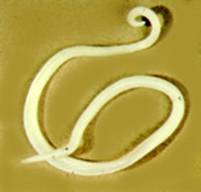 |
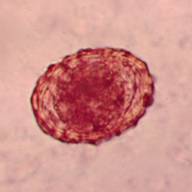 |
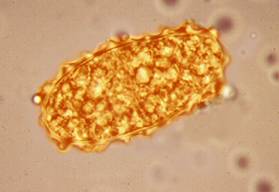 |
| Adult male Ascaris | Ascaris fertilized egg | Ascaris unfertilized egg |
 |
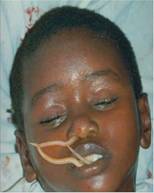 |
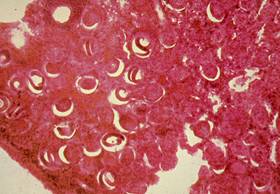 |
| Ascaris cross-section in appendix | Migrating adult worm | Ascaris larvae in lung (migration) |
Life Cycle:
On ingestion, the eggs hatch in the stomach and duodenum, where the larvae actively penetrate the intestinal wall; they are then carried to the right heart via the hepatic portal circulation. Then the larvae are carried into the pulmonary circulation, where they are filtered out by the capillaries. Infection in humans is acquired through ingestion of the embryonated eggs from contaminated soil. On ingestion, the eggs hatch in the stomach and duodenum, where the larvae actively penetrate the intestinal wall; they are then carried to the right heart via the hepatic portal circulation. Then the larvae are carried into the pulmonary circulation, where they are filtered out by the capillaries. After approximately 10 days in the lung, the larvae break into the alveoli, migrate via the bronchi until they reach the trachea and pharynx, and then are swallowed. The worms then mature and mate in the intestine, with the eventual production of eggs, which are passed in the stool. The entire developmental process from egg ingestion to egg passage from the adult female takes from 8 to 12 weeks. During her life span, she may deposit a total of 27,000,000 eggs. Both unfertilized and fertilized eggs are passed. Often only female worms are recovered from the intestine. Fertilized eggs will become infective within 2 weeks if they are in moist, warm soil, where they may remain viable for months or even years. Often both types of eggs are found in the same stool specimen. The total absence of fertilized eggs means that only female worms are present in the intestine.
Acquired:
Infection in humans is acquired through ingestion of the embryonated eggs from contaminated soil.
Epidemiology:
Worldwide, primarily human to human transmission
Clinical Features:
Intestinal disease can often be diagnosed from radiographic studies of the gastrointestinal tract, where the worm intestinal tract may be visualized. This may be particularly obvious when two worms are lying parallel, like ``trolley car lines.” Other involved body sites may present specific symptoms indicative of bowel obstruction, biliary or pancreatic duct blockage, appendicitis, or peritonitis. Therapeutic measures are related to specific symptoms and involved areas.
NOTE: In children, particularly those under the age of 5, there may be severe nutritional impairment related to the worm burden. Directly effects include increased fecal nitrogen and fecal fat and impaired carbohydrate absorption, all of which would return to normal with elimination of the adult worms. Worms can also be spontaneously passed without any therapy. Developmental disabilities are a significant and frequently undetected health problem in developing countries; malnutrition associated with intestinal helminth infections may be an important contributory factor for these disabilities.
Clinical Specimen:
Stool: The standard O&P examination is the recommended procedure for recovery and identification of A. lumbricoides eggs in stool specimens, primarily from the wet preparation examination of the concentration sediment.
Sputum, Gastric Washings: In the larval migration phase of the infection, diagnosis can be made by finding the larvae in sputum or in gastric washings.
Laboratory Diagnosis:
Stool: During the intestinal phase, the diagnosis can be made by finding the eggs (unfertilized or fertilized) or adult worms in the stool. The eggs are most easily seen on a direct wet smear or a wet preparation of the concentration sediment. Remember that the unfertilized Ascaris eggs will not float with use of the zinc sulfate flotation concentration method (the eggs are too heavy). Also, if too much iodine is added to the wet preparations, the eggs may look like very dark debris. Eggs may be very difficult to identify on a permanent stained smear because of stain retention and asymmetrical shape.
Organism Description:
Fertilized egg: The fertilized egg is broadly oval, with a thick, mammillated coat, usually bile stained a golden brown. These eggs measure up to 75 µm long and 50 µm wide. The mammillated (bumpy, tuberculated) coat appears less pronounced that that seen in the unfertilized eggs. In proficiency testing specimens, some fertilized eggs will continue to mature and you may actually see motile larvae within the egg shell.
Unfertilized egg: Unfertilized eggs are usually more oval, measure up to 90 µm long, and may have a pronounced mammillated coat or an extremely minimal mammillated layer.
It is important to remember that the unfertilized eggs tend to be heavy; consequently, they will not float when using the zinc sulfate flotation concentration procedure.
Laboratory Report:
Ascaris lumbricoides eggs present (it is not necessary to specify fertilized or unfertilized eggs)
Ascaris lumbricoides adult worm
Treatment:
Infection may be aborted by spontaneous passage of adult worms within about a year.
Garcia, L.S. 2007. Diagnostic Medical Parasitology, 5th ed., ASM Press, Washington, D.C.
Control:
There are apparently no practical means of killing the eggs while they are in the soil, especially when they are in clay soil under favorable environmental conditions. In some areas of the world where infections are common, some mass population treatment plans have been used with great success, even in areas with high reinfection rates. The use of human feces, or "night soil," for fertilization of crops should be recognized as a potential hazard. Any vegetables or fruits from such fields cannot be eaten raw or unprocessed. Even with proper pretreatment of night soil, Ascaris eggs remain viable and infective more often than eggs of any other helminth species.